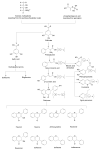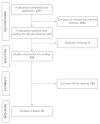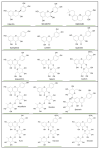An Integrative Approach to the Flavonoid Profile in Some Plants' Parts of the Annona Genus
- PMID: 36365309
- PMCID: PMC9656113
- DOI: 10.3390/plants11212855
An Integrative Approach to the Flavonoid Profile in Some Plants' Parts of the Annona Genus
Abstract
The Annonaceae family is widely distributed in subtropical and tropical regions. Several species of this family are known for their pharmacological and beneficial properties to human health, mainly attributed to flavonoids. The objective of this work was to carry out an integrative review in order to identify the main flavonoids found in some plant parts belonging to the Annona genus: araticum tree (Annona crassiflora Mart.), graviola tree (Annona muricata), atemoya tree (Annona cherimolia Mill × Annona squamosa L.), pinha tree (Annona squamosa), bananinha tree (Annona leptopetala), and marolinho tree (Annona coriacea). Only articles published between the years 2016 to 2021 that answered the guiding question were considered, in order to obtain recent data. Then, search strategies were designated for each database used: Science Direct, CAPES Periodicals, and Scielo. Most of the studies retrieved from the databases are related to fruits. The results showed that the number of flavonoids identified varies according to the analytical methodology used to identify and quantify the compounds. Quercetin was the most commonly found compound in all fruits of the Annona genus studied, and epicatechin, rutin, and kaempferol were also found to a lesser extent. The presence of these compounds in Annona makes the fruit promising, with potential applicability in the pharmaceutical and food industry.
Keywords: Annona cherimolia Mill × Annona squamosa L.; Annona coriacea; Annona crassiflora Mart.; Annona muricata; Annona squamosa; flavonoids.
Conflict of interest statement
The authors declare no conflict of interest.
Figures









References
-
- Barosa L.T.C., Vega M.R.G. Diterpenos Do Gênero Xylopia. Rev. Virtual Quim. 2017;9:1712–1733.
-
- Hamonnière M., Leboeuf M., Cavé A. Alcaloides Aporphiniques et Composés Terpéniques Du Polyalthia Oliveri. Phytochemistry. 1977;16:1029–1034. doi: 10.1016/S0031-9422(00)86716-3. - DOI
-
- Bhalk R.D., Chavan M.J. Analgesic and CNS Depressant Activities of Extracts of Annona Reticulata Linn. Bark. Phytopharmacology. 2011;1:160–165.
Publication types
LinkOut - more resources
Full Text Sources

